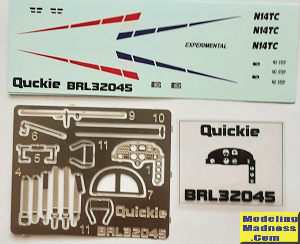
| KIT #: | BRL32045 |
| PRICE: | $70.00 |
| DECALS: | One option |
| REVIEWER: | John Summerford |
| NOTES: | Resin and p.e. with vac canopy |

| HISTORY |
The Quickie is a tandem wing taildragger, meaning, one forward wing and one rear wing. Typical of Rutan designs, it is constructed of glass fiber and resin over a foam core. The wings are foam blanks cut to shape with a hot wire before covering, and the fuselage made up of 1 inch-thick (25.4 mm) foam slabs.
The forward wing provides around 60% of the lift. The full-span control surfaces on the forward wing serve as combined elevators and flaps. Ailerons are located inboard on the rear wing which is shoulder-mounted just aft of the pilot. The tandem layout provides positive lift from both pairs of wings.
The Quickie has fixed main wheels faired into spats located at the tips of the forward wing. The absence of separate landing gear helps to reduce both weight and drag. Such savings allow a smaller engine and a smaller fuel tank.
Pilot controls include a hand grip on the right and a throttle on the left. The rudder pedals are linked to a steerable tailwheel.
The Quickie evolved from Tom Jewett and Gene Sheehan’s planning in 1975 for a low-cost, low-power, single-seat homebuilt aircraft. The first element to be found by Jewett and Sheehan was the engine, which – although low-powered (they had anticipated 12 hp) – had to be reliable for aviation work. With the help of Onan, a manufacturer of industrial four-stroke engines, they were able to procure a 70 lb. (32 kg) engine that would deliver 18 hp (14 kW) at 3,600 rpm.
When Burt Rutan became involved with the project. Sheehan and Jewett suggested a scaled-down Vari-Eze. After some consideration, the pusher/canard configuration design was discarded. Instead, Rutan proposed a tractor engine/tandem wing layout. This placed the pilot close to the center of gravity. The tandem layout also gave safe stalling characteristics. Rutan produced the first drawings in May 1977 and the trio worked on the design drawings over the next two months. Prototype construction began in August.
After the first flights, Rutan spent more time with other projects, so Jewett and Sheehan continued development of the design and marketing on their own. An agreement was reached that Rutan would fund the development and testing and they would pay Rutan back from future sales of the kits. The Quickie Aircraft Corporation was formed to produce and market the Quickie in kit form in early 1978.
In June, a Quickie prototype was flown to the Experimental Aircraft Association's annual gathering at EAA’s Air Venture at Oshkosh, Wisconsin, where the aircraft drew intense public interest and won the Outstanding New Design Award.
| THE KIT |
 Quickies
are small aircraft and, even in 32nd
scale, make for small models. The sturdy corrugated board box that holds the
parts measures only 7 ¼ inches by 5 ¼ inches by 1 5/8 inches. Inside one will
find 14 gray resin parts, one clear vac-u-formed canopy, 14 photo-etch parts, an
acetate sheet of instruments, and a small decal sheet. The resin is well cast. A
nice touch is that two sets of the detail parts are included. (Bringing the
total of resin parts to 22.) On this example, the only pin holes present are on
the underside of the fuselage and, unfortunately, the seat is brok
Quickies
are small aircraft and, even in 32nd
scale, make for small models. The sturdy corrugated board box that holds the
parts measures only 7 ¼ inches by 5 ¼ inches by 1 5/8 inches. Inside one will
find 14 gray resin parts, one clear vac-u-formed canopy, 14 photo-etch parts, an
acetate sheet of instruments, and a small decal sheet. The resin is well cast. A
nice touch is that two sets of the detail parts are included. (Bringing the
total of resin parts to 22.) On this example, the only pin holes present are on
the underside of the fuselage and, unfortunately, the seat is brok en
into two pieces, but that should not be noticeable once the harness is in place.
en
into two pieces, but that should not be noticeable once the harness is in place.
Instructions are printed on both sides of a 15 cm by 21 cm sheet and has a parts map, assembly sequence and paint/decal diagram. No information about Quickies or what type of glue and paint to use is included.
 The first
three steps call for making subassemblies of the seat, balancers for the front
wing control surfaces, and instrument panel respectively. Implied is the
attaching of the nose piece to the fuselage. From there, the cockpit is
detailed. On the backside of the instruction sheet, the wings and fuselage are
mated, then the wheels, prop, and canopy. Paint and decal information is the
final section.
The first
three steps call for making subassemblies of the seat, balancers for the front
wing control surfaces, and instrument panel respectively. Implied is the
attaching of the nose piece to the fuselage. From there, the cockpit is
detailed. On the backside of the instruction sheet, the wings and fuselage are
mated, then the wheels, prop, and canopy. Paint and decal information is the
final section.
| CONCLUSIONS |
With such a low parts count, this is a straight forward build. The balancers and tail wheel (the strut is not included) are a bit fiddley, but even those with limited experience should be able to create a fine model.
Brengun also offers a 48th and 72nd scale version of the Quickie.
June 2022
Copyright ModelingMadness.com. All rights reserved. No reproduction in part or in whole without express permission.
If you would like your product reviewed fairly and fairly quickly, please contact the editor or see other details in the Note to Contributors.